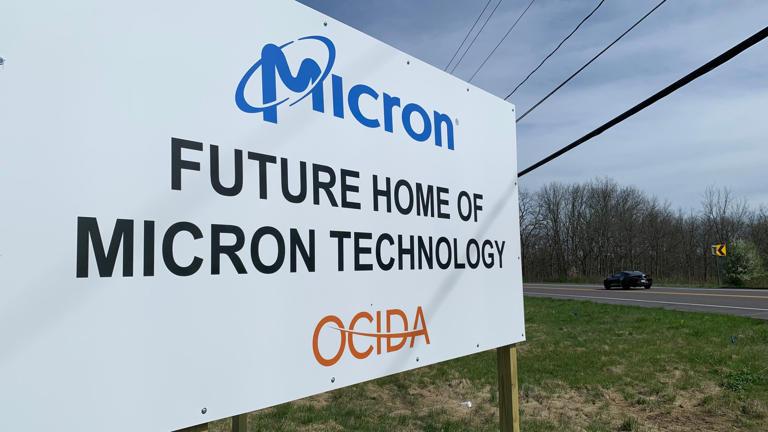Just over two years ago, Micron Technology announced it would build, with substantial help from taxpayers, the nation’s largest chipmaking complex in the northern suburbs of Syracuse.
Construction was scheduled to start in June 2024. That was pushed back to early 2025. And now, groundbreaking won’t start until at least November 2025, nearly a year and half behind the original schedule.
At the same time, all of the other major chipmakers that have won big awards from the federal CHIPS Act are putting up factories and installing equipment across the country. Even Micron is pouring 30,000 tons of concrete a week at a chip plant it’s building — in Idaho.
In the town of Clay, however, the 1,400-acre site where Micron proposes to build four massive factories remains heavily forested and brimming with wetlands. Micron’s only presence there are several plywood signs.
The main reason for the holdup? Micron hasn‘t finished the massive environmental impact report required by the state and federal governments to move the project forward.
It’s a complicated task. The draft environmental impact statement will be thousands of pages long and must analyze in detail the project‘s effects on everything from air pollution and traffic to its impact on the housing market to details about its construction timelines.
And even after it submits that document to federal and local governments, that will jumpstart a series of public hearings and reviews likely to take many more months.
Micron faces some hurdles in Clay that its competitors don’t in other parts of the county.
Those include bats, green spaces and New York’s environmental regulations.
Bob Petrovich, executive director of the county Industrial Development Agency, noted that the other projects, including Micron’s own in Boise, aren’t as big and don’t require as much environmental review as the Clay project.
“This is a large, unprecedented project in terms of scope and scale, not only for Micron, but for New York, even for the country,” Petrovich said. “I don’t compare this project to any other project, because it’s a project that’s unique unto itself.”
The Clay site is replete with wetlands, which can’t be filled in without special permission from the federal government. Also on the site are two species of endangered bats, which requires another level of federal review and limits when Micron can fell trees.
But there may be more to Micron’s delays than environmental issues, experts in the chip industry say. The highly cyclical chip industry is still rebounding from a big downturn, and chipmakers are wary of spending too much money in case another downturn hits, said Jim Handy, a semiconductor analyst with Objective Analysis in Silicon Valley.
In addition, Handy said, the artificial intelligence boom that companies like Micron are counting on is moving more slowly than initially forecast.
Micron isn’t under an immediate time crunch to get the Clay project going. The grant money it’s been promised from the state and federal government comes only after the company meets construction and employment benchmarks. There’s no penalty for starting later.
The biggest slice of the subsidy pie, however, does come with a deadline. Micron must start construction by the end of 2026 to qualify for a tax credit that could be worth $11.5 billion on the first two fabs. That’s more than half of the estimated $20 billion in taxpayer subsidies that Micron is counting on for those two fabs.
On Oct. 4, 2022, Micron announced it planned to spend up to $100 billion to build four fabrication plants, or fabs, at Route 31 and Caughdenoy Road. The company was spurred by the federal CHIPS and Science Act, designed to bring chipmaking back to the U.S. The vast majority of chips are made overseas, especially in Taiwan.
Micron specializes in memory chips, tiny devices that temporarily store information on everything from cell phones to cars to artificial intelligence servers. Micron is the only U.S.-based maker of memory chips and produces nearly all of them in Asia.
Building the fabs to produce those tiny chips is among the most challenging construction projects on the planet. Each fab is 180 feet high, sprawls across 28 acres of land, and contains hundreds of miles of pipes that convey toxic chemicals used in the chipmaking process. Thick floors dampen vibration for the hundreds of highly calibrated machines that imprint minuscule patterns on the 12-inch discs of silicon. Those discs are eventually diced into chips, each no bigger across than a pinkie fingernail and as thick as a human hair.
Micron could churn out more than 700 million chips a year in the first two fabs in Clay. Volume is critical in the business of memory chips, which are interchangeable with those made by competitors. Users of Micron chips can swap them out for another brand like photographers swap SD cards into their cameras, Micron said.
Construction was scheduled to start in June 2024; that’s now fall 2025, assuming the lengthy review process is done and Micron has obtained a lengthy list of approvals and permits.
While the environmental report is being compiled, Micron has moved forward on many other fronts in Central New York. The company has already hired at least 20 people for the Clay site, primarily in construction planning. Micron announced it will open offices in downtown Syracuse’s sixth-tallest building [the One Lincoln Plaza Building, at the corner of West Fayette and South Clinton Street] sand has hired the world’s largest design firm [Jacobs Engineering] to draw detailed plans of the fabs.
“It’s complicated and it’s involved, but it doesn’t mean it’s not going to happen,” said Petrovich, the county’s industrial development agency director. “We’re making progress.”
Found on mainstream news.

